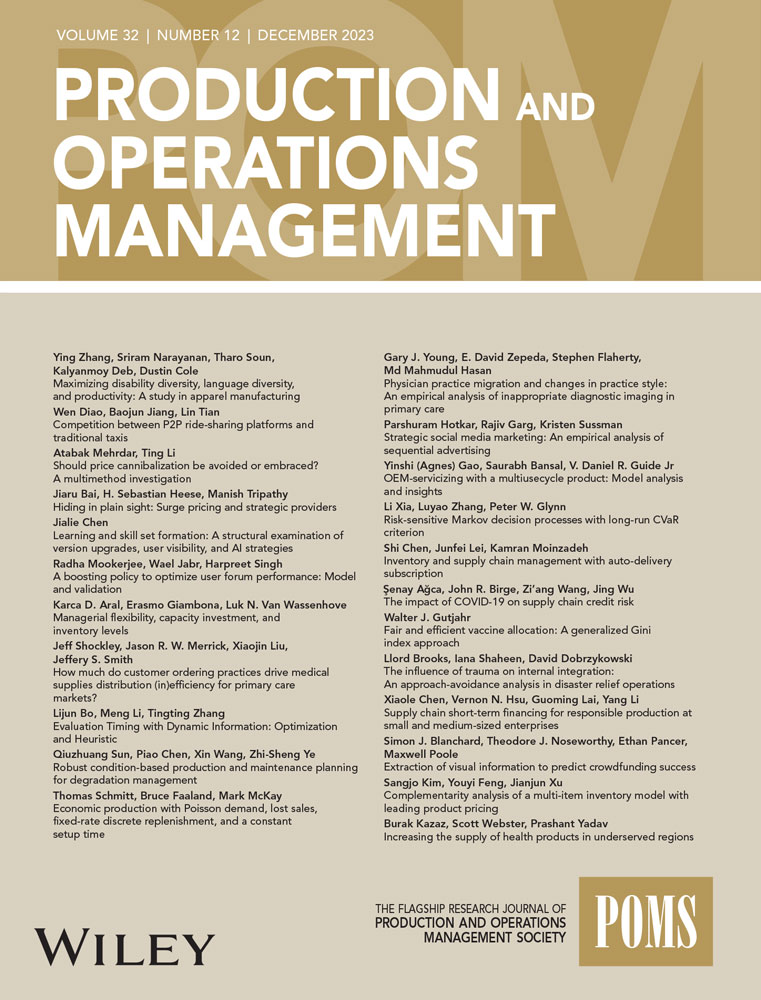Commitment strategies and inventory decisions under supply disruption risk
IF 4.8
3区 管理学
Q1 ENGINEERING, MANUFACTURING
引用次数: 1
Abstract
Abstract Pandemics, trade frictions, and military conflicts may disrupt manufacturers' production capacity. This paper develops a two‐period supply chain model with supply disruption risk in the second period to investigate inventory decisions and the manufacturer's commitment strategies. We consider three strategies: no commitment, price commitment, and inventory commitment. Inventory holding within the supply chain is investigated under each strategy, and the dominant strategy is determined by comparing them. Distinct results arise due to supply disruption risk. First, the retailer may have two opposite motives for inventory holding: inventory‐building motive and inventory‐shifting motive (i.e., shifting inventory burden to the manufacturer by decreasing order quantity), where the latter is exclusive to situations with supply disruption risk. Price commitment suppresses both motives, and inventory commitment suppresses only inventory shifting. Second, the retailer never holds inventory under price commitment. Under no commitment and inventory commitment, for high (low) holding cost and disruption risk, only the manufacturer (retailer) holds inventory. Furthermore, the manufacturer's inventory may decrease as disruption risk increases. Third, regarding strategy choice, while each strategy can be the dominant choice for the retailer and the supply chain, the manufacturer (weakly) prefers inventory commitment to the other two strategies. However, the implementation of inventory commitment demands high supply chain transparency, as the manufacturer always has an incentive to secretly deviate by holding less inventory. When inventory commitment is infeasible, the price commitment strategy's performance varies compared to no commitment, contrasting with the disruption risk‐free literature where wholesale price commitment never outperforms no commitment.供应中断风险下的承诺策略与库存决策
流行病、贸易摩擦和军事冲突可能会破坏制造商的生产能力。本文建立了一个包含第二阶段供应中断风险的两期供应链模型,用于研究库存决策和制造商承诺策略。我们考虑三种策略:不承诺、价格承诺和库存承诺。研究了每种策略下供应链的库存持有情况,并通过比较确定了优势策略。由于供应中断的风险,会产生明显的结果。首先,零售商可能有两种相反的库存持有动机:库存建立动机和库存转移动机(即通过减少订单数量将库存负担转移给制造商),后者仅适用于存在供应中断风险的情况。价格承诺抑制这两种动机,而库存承诺只抑制库存转移。其次,零售商从不在价格承诺下持有库存。在没有承诺和库存承诺的情况下,由于高(低)持有成本和中断风险,只有制造商(零售商)持有库存。此外,制造商的库存可能会随着中断风险的增加而减少。第三,关于策略选择,虽然每种策略都可以成为零售商和供应链的主导选择,但制造商(弱)更倾向于库存承诺而不是其他两种策略。然而,库存承诺的实施对供应链的透明度要求很高,因为制造商总是有通过持有较少库存来暗中偏离的动机。当库存承诺不可行时,价格承诺策略的表现与没有承诺相比有所不同,而在无中断风险的文献中,批发价格承诺的表现永远不会优于没有承诺。
本文章由计算机程序翻译,如有差异,请以英文原文为准。
求助全文
约1分钟内获得全文
求助全文
来源期刊

Production and Operations Management
管理科学-工程:制造
CiteScore
7.50
自引率
16.00%
发文量
278
审稿时长
24 months
期刊介绍:
The mission of Production and Operations Management is to serve as the flagship research journal in operations management in manufacturing and services. The journal publishes scientific research into the problems, interest, and concerns of managers who manage product and process design, operations, and supply chains. It covers all topics in product and process design, operations, and supply chain management and welcomes papers using any research paradigm.
 求助内容:
求助内容: 应助结果提醒方式:
应助结果提醒方式:


